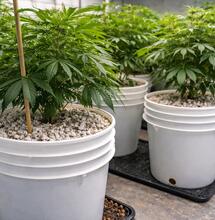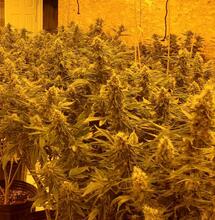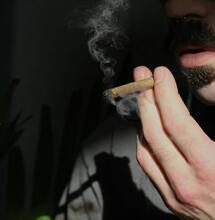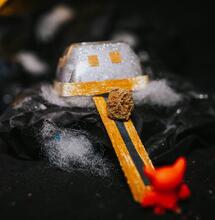How to Grow Sour Diesel?
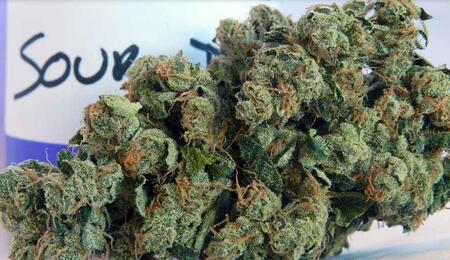
Sour Diesel is one of the most iconic marijuana strains - it has reigned over the market since the early 1990s. It also goes by the names “Sour D” and “Sour Deez”; its smell is reminiscent of gasoline, skunk, and lemon. In fact, it’s one of the strains with the most pungent fragrance of all. Besides the strong scent, Sour Diesel cannabis also gives a refreshing, uplifting head high, and is used among both recreational and medical users. Scroll down to see how you can grow this cannabis strain by yourself.
Sour Diesel is a classic cannabis strain; with its beautiful green leaves, ornate with pink-orange pistils, it also has the classic marijuana looks. THC contents can range between 18% and 25%, as smoking the strain is prompt to give users an energizing warm cerebral high. It’s a fast-acting, mood-improving smoke, beloved among cannabis consumers. For those who use cannabis to benefit their health, Sour Diesel helps with relief from stress, pains, anxiety, and depression.
Genetics: Sour Diesel is predominantly sativa strain (90%), embellished with traces of indica (10%). It’s a cross between Chemdawg and Super Skunk, which explains why Sour D turned out such a smelly dunk but also why it has such lovely invigorating effects. The first parent strain Chemdawg is a very potent hybrid with a distinctly gasoline-like aroma. The second parent, Super Skunk, borrows the more medicinal properties of Sour D; it’s an indica cannabis strain, the result of crossing Skunk #1 and Afghani, which typically produces a strong body buzz, relaxing all muscles.
Smell and flavor: Some people will undoubtedly find Sour Diesel’s pungent odor and taste unpleasing, until they are hooked on the strain for the effects. Its emblematic diesel-like fragrance is fused with skunk and lemon. It may not be nice if you are not into it, but it’s worth it, once the overall effect of the strain takes over the body.
Terpenes: Sour D is particularly rich in Caryophyllene, which is also found in clove, rosemary, and hops. With potent anti-inflammatory and antimicrobial properties, Caryophyllene adds up to the medicinal qualities of Sour D.
Effects: Sour Diesel generates a much sought-after sensation that makes you feel happy, delighted, and pain-free.
Medicinal use: The strain is particularly effective for improving mood. Patients suffering from depression, anxiety, and chronic pains, have often found relief in Sour D. Medical use has shown Sour Diesel cannabis offers a long-lasting comfort if consumed rationally. In other words, avoid overconsumption when you specifically want to use it for mood disorders treatment. Excess consumption may cause Sour D. (or any other cannabis strain) to backfire and intensify negative reactions such as paranoia, panic, and stress.
Side effects: It can generate typical effects such as cottonmouth and dry mouth. In some very rare instances, some users have reported paranoid thoughts, in which case you should look for a strain that works better for your mind and body.
Lifestyle: It’s a great smoke to share with friends; Sour D will keep you social. It’s also your go-to medicine after long and nerve-racking days.
Difficulty growing: It takes some advanced growing skills to properly cultivate Sour Diesel plants. It takes efforts in pruning and training, correct humidity management, pest protection, and a particular nutrient strategy to yield this weed strain successfully.
What Is the Best Way to Grow Sour Diesel Cannabis?
For the best results, Sour D should be grown outdoors, where it takes up to 11 weeks to flower, and can yield 18 ounces per 10 square feet planted. Inside, Sour D will struggle if placed in a small grow room. The plant grows at a decent length; therefore, it requires low-stress training techniques to support its anatomy.
Training will improve the harvest of your Sour D. crops, given that also other essential factors are taken care of. Such as the temperature - it should not go above 80°F when growing indoors. Sour D. will appreciate its intake of natural fertilizers, too.
Ideally, you'll grow Sour D. outside, but even in a state where this is legal to do, you should still protect your plant from unwanted attention. When happy, Sour Diesel crops can reach up to 10 feet in height, which makes it more challenging to keep your activity a secret. Pruning will help but putting other strategies at work is also recommended. Such as having a tall fence around your garden, or planting your cannabis plants between other trees that are obstructing the view from the street.

How to Train Sour D Plants?
With Sour D, the focus goes on Low-Stress (LST) training; the primary purpose is to expose all plant buds to light, especially those found on the lower part of the plant. When done correctly, LST should improve yields at the end of the flowering cycle.
Soft plant ties, wooden skewers, and duct tape can be used to perform LST and promote bud formation. Begin by bending the plant’s shoots outwards, and give enough distance from the main stem. Use plant ties to fix down the nodes, and duct tape if some of the branches breaks during the process. However, duct tape will not help if there is heavy damage on the branch.
Other tips:
- Don’t forget to adjust the bends as Sour Diesel crops grow.
- Another round of training may be needed as plants progress through vegetation.
- All training should be done during the vegetative phase. Once plants enter blooming time, stems become unbendable.
What Is the Ideal Climate for Sour Diesel Plants?
Sour D ideally thrives in warm Mediterranean-like climates. Whether you don’t live in someplace like sunny California, you may have to mimic a similar friendly environment in your indoor grow room.
In a warm outdoor setting, Sour D will need sufficient space to thrive and reach its full potential. Its typical harvest time is late October or early November. During the last weeks of flowering, the buds become elegantly coated with trichomes, a real feast for the eyes.
Indoors, control the room temperature between 65 and 80°F. At night, it’s important to make sure temperatures do not fall for more than 10-15 degrees. When the temperature is well maintained, it contributes to optimal carbon dioxide (CO2) processing, and better humidity balance.
It won’t be necessary to increase the temperature when the lights are working. The lamps alone will contribute to a steady room temperature. Then, when lights go off, it’s good to use a heater or a radiator with a thermostat that will continue to regulate the temperature. Pay attention if you use HPS lamps, especially in a small room where the extra warmth emitted from this type of light can quickly accumulate and prove lethal for Sour D.
How to Manage Humidity Levels?
If you are growing Sour D. indoors, humidity levels should stay in the range of 65-70% when the plants are in the vegetation period. Once they start flowering, drop humidity by up to 15% during the day, and up to 20% during the night.
Making humidity mistakes can cause disbalance with the uptake of water from the soil. Which triggers a chain of other reactions where the plant’s stomata begin to malfunction, CO2 processing is at threat, and subsequently, it all slows down growth and has an impact on the yield.
One of the worse scenarios is excess humidity, such as exposing Sour Diesel to over 80% humidity levels. This may entirely compromise the growing efforts by attracting fungi and bacteria. A fast reaction is much needed in this case: use an extractor fan with a filter to help stabilize humid rooms.
A hygrometer should help monitor humidity levels; it’s a particularly handy instrument to have when the grow is confined to a small and limited area.
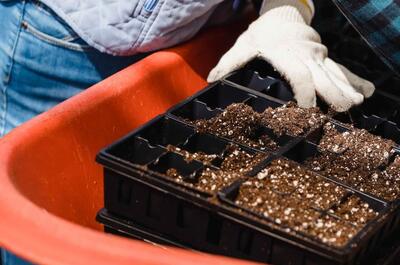
How to Protect Sour D Plants from Pests?
Growing outdoors, you'll need to take care of two things to protect your Sour D crops. The first is, protect your plants from prying eyes. Second, protect it from mites and any other insect that likes a bite of your cannabis plants and leaves.
You can adopt some cheap and convenient solutions for outdoor crops to keep chemicals at bay, or ultimately go organic. For example, you can apply cinnamon at the base or roots to shield Sour D from aphids, whiteflies, and mildew. Alternatively, you can prepare a concoction that contains cinnamon oil and spray it around the plant’s base.
If there’s a greater issue of caterpillars, ants, and spider mites, you can opt for a concoction that contains clove oil - it works as an excellent repellent.
For more natural feeds and concoctions that can replenish and protect your Sour D cannabis garden, read the article here.
What Is the Nutrient Regime for Sour Diesel?
Focus on nitrogen during the vegetative stage. During this time, Sour Diesel will benefit from double amounts of nitrogen that of phosphorus and potassium. You can start with a solution with 6-3-2 (N-P-K) ratio. In the flowering stage, dispense more phosphorus on Sour Diesel; look for a nutrient fertilizer that contains three times more of this element than the other two.
In addition, at each stage, Sour Diesel plants demand secondary nutrients like magnesium, calcium, sulfur, iron, copper, and manganese.
As the harvest approaches, make sure you timely stop dispensing all fertilizers, so that the buds retain a more natural taste and smell later on.
How to Handle Your Harvest?
If all goes well, Sour Diesel will generate a yummy yield, which you still have a little more work to do until all is well taken care of. After finishing with the harvest, remove the fan leaves - they are not potent and they can’t cure properly. But you can perhaps use them to prepare cannabutter.
For drying and curing, the most suitable environment is to keep room temperatures at 70°F and 50% humidity. The room where you hang the plant material should be kept dark, with low air circulation. It will take a couple of days for the Sour D plants to dry and get ready for curing.
Happy growing!
More grow guides from Soft Secrets:

